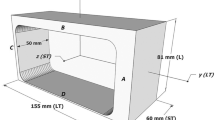Abstract
The purpose of this study is to reduce the residual stress and machining distortion of an Al6061 tube by using uphill quenching. During uphill quenching, solid-solution heat-treated aluminum parts are usually immersed in LN2 at 77 K (−196 °C), followed by the rapid heating of the parts, to produce a new residual stress that is opposite in nature to the original. The uphill quenching method used in this study employed two types of heating methods: boiling water at 373 K (100 °C) and high-velocity steam at 448 K (175 °C). First, FE-simulation coupled with a CFD analysis was performed to predict the residual stress of the backward hot-extruded Al6061 tube with the following dimensions: Ø200 mm × h200 mm × t10 mm. Experiment of uphill quenching was also conducted to measure the residual stress using the boiling water and high-velocity steam uphill quenching methods. The predicted residual stresses were compared with the experimental results obtained via micro-indentation and saw-cutting tests, and a deviation of about 10.4 pct was found. In addition, the experimental results showed that uphill quenching could relieve up to 91 pct of the residual stress induced by water quenching. Finally, the dimensional accuracy of uphill quenched tubes was evaluated by measuring the roundness after the machining process, which showed that the uphill quenching method could improve the dimensional accuracy of an Al6061 tube by reducing the residual stress.












Similar content being viewed by others
References
M. Rogante, P. Battistella and F. Rustichelli: Jour. A. and Compo., 2004, Vol 378, pp. 335–338.
G. P. Dolan and J. S. Robinson: Jour. Mater. Pro. Tech., 2003, Vol. 153, pp. 346–351.
I. Mitchell: Master’s Thesis, Worcester Polytechnic Institute, Worcester, MA, 2004.
N. h. hill, R. S. Barker, L. A. Willey: ASM 52, (1960), pp. 657–674.
Q. C. Wang, L. T. Wang and W. Peng: Mater. Sci. For., 2005, Vol. 490, pp. 91–101.
E.C.A. Simencio, L.C.F. Canale, and G. E. Totten: Int. Heat Treat. Surf. Eng., 2011, vol. 5 (1), pp. 26–30.
D. A. Lados, D. Apelian and L. Wang: Mater. Sci. Eng. A, 2010, Vol. 527, pp. 3159–3165.
T. Croucher: J. ASTM Int., 2009, Vol. 6(7), pp. 23–36.
M. C. Berger and J. K. Gregory: Mater. Sci. Eng. A, 1999, Vol. 263, pp. 200–204.
P. Juijerm, I. Altenberger and B. Scholtes: Mater. Sci. Eng. A, 2006, Vol. 426, pp. 4–10.
C. Simsir and C. h. Gur: Jour. Mater. Pro. Tech., 2008, Vol. 207 pp. 211–221.
S. hossain, C. E. Truman, D. J. Smith, R. L. Peng and U. Stuhr: Inter. Jour. Sol. Stru., 2007, Vol. 44, pp. 3004–3020.
J. I. Jang, D. I. Son, Y. h. Lee, Y. Choi and D. I. Kwon: Scrip. Mater., 2003, Vol. 48, pp. 743–748.
Y. h. Lee and D. I. Kwon: Acta Mater., 2004, Vol. 52, pp. 1555–1563.
J. W. Park and L. F. Jack: Dent. Mater., 2005, Vol. 21, pp. 882–889.
Micheal B. Prime and Micheal R. hill: Scrip. Mater., 2002, Vol. 46, pp. 77–82.
ISO 12181-1: 2011, Geometrical Product Specifications (GPS): Roundness. Part 1: Vocabulary and Parameters of Roundness, 2011.
Acknowledgments
This work was supported by the National Research Foundation of Korea (NRF) grant funded by the Korea government (MSIP) (No. 2013R1A5A1048294).
Author information
Authors and Affiliations
Corresponding author
Additional information
Manuscript submitted January 9, 2013.
Rights and permissions
About this article
Cite this article
Lim, HJ., Ko, DH., Ko, DC. et al. Reduction of Residual Stress and Improvement of Dimensional Accuracy by Uphill Quenching for Al6061 Tube. Metall Mater Trans B 45, 472–481 (2014). https://doi.org/10.1007/s11663-013-9997-3
Published:
Issue Date:
DOI: https://doi.org/10.1007/s11663-013-9997-3




